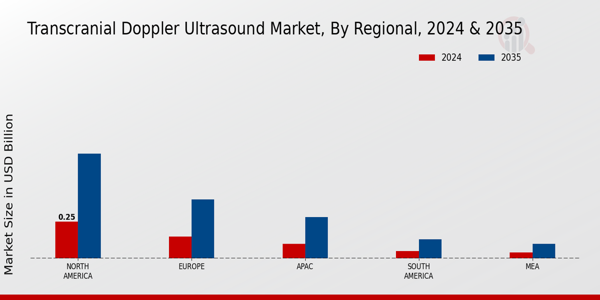Market Growth Projections
The Global Transcranial Doppler Ultrasound Market Industry is projected to experience substantial growth, with estimates indicating a market value of 0.59 USD Billion in 2024 and a potential increase to 1.5 USD Billion by 2035. This growth trajectory suggests a robust compound annual growth rate (CAGR) of 8.85% from 2025 to 2035, reflecting the increasing adoption of transcranial Doppler ultrasound technology in clinical practice. The market dynamics are influenced by various factors, including technological advancements, rising healthcare expenditure, and the growing prevalence of neurological disorders.
Rising Geriatric Population
The aging population globally is a crucial driver for the Global Transcranial Doppler Ultrasound Market Industry. With the proportion of individuals aged 65 and older expected to double by 2050, the demand for effective diagnostic tools for age-related neurological conditions is likely to escalate. This demographic shift necessitates the implementation of advanced diagnostic methods, including transcranial Doppler ultrasound, to monitor and manage cerebral health in older adults. Consequently, the market is poised for substantial growth, as healthcare systems adapt to the needs of an aging population.
Increased Healthcare Expenditure
The Global Transcranial Doppler Ultrasound Market Industry benefits from rising healthcare expenditure across various nations. Governments and private sectors are investing significantly in healthcare infrastructure, which includes the procurement of advanced diagnostic equipment. This trend is particularly evident in emerging economies, where increased funding for healthcare is aimed at improving diagnostic capabilities. As healthcare budgets expand, the adoption of transcranial Doppler ultrasound technology is likely to rise, further driving market growth and enhancing patient care.
Rising Incidence of Neurological Disorders
The Global Transcranial Doppler Ultrasound Market Industry experiences growth driven by the increasing prevalence of neurological disorders such as stroke and dementia. As per recent statistics, the incidence of stroke is projected to rise, with an estimated 12 million new cases globally by 2030. This surge necessitates advanced diagnostic tools like transcranial Doppler ultrasound, which offers real-time monitoring of cerebral blood flow. The market is expected to reach 0.59 USD Billion in 2024, reflecting the urgent need for effective diagnostic solutions in neurology.
Technological Advancements in Ultrasound Devices
Technological innovations significantly enhance the capabilities of transcranial Doppler ultrasound devices, thereby propelling the Global Transcranial Doppler Ultrasound Market Industry. Recent advancements include portable and handheld devices that improve accessibility and ease of use in various clinical settings. These innovations not only facilitate timely diagnosis but also contribute to better patient outcomes. As the market evolves, the integration of artificial intelligence and machine learning in ultrasound technology is anticipated to further optimize diagnostic accuracy and efficiency, potentially increasing market value to 1.5 USD Billion by 2035.
Growing Demand for Non-Invasive Diagnostic Techniques
The Global Transcranial Doppler Ultrasound Market Industry is witnessing a shift towards non-invasive diagnostic methods, driven by patient preference and clinical efficacy. Transcranial Doppler ultrasound stands out as a non-invasive technique that provides critical insights into cerebral hemodynamics without the risks associated with invasive procedures. This trend aligns with the broader healthcare movement towards patient-centered care, where safety and comfort are prioritized. As a result, the market is projected to grow at a CAGR of 8.85% from 2025 to 2035, reflecting the increasing adoption of non-invasive technologies.




















